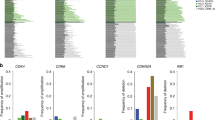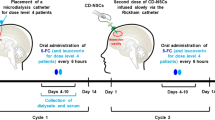Abstract
Malignant glioma is a fatal human cancer in which surgery, chemo- and radiation therapies are ineffective. Therapeutic gene transfer used in combination with current treatment methods may augment their effectiveness with improved clinical outcome. We have shown that NUREL-C2, a replication-defective multigene HSV-based vector, is effective in treating animal models of glioma. Here, we report safety and biodistribution studies of NUREL-C2 using rhesus macaques as a model host. Increasing total doses (1 × 107 to 1 × 109 plaque forming units (PFU)) of NUREL-C2 were delivered into the cortex with concomitant delivery of ganciclovir (GCV). The animals were evaluated for changes in behavior, alterations in blood cell counts and chemistry. The results showed that animal behavior was generally unchanged, although the chronic intermediate dose animal became slightly ataxic on day 12 postinjection, a condition resolved by treatment with aspirin. The blood chemistries were unremarkable for all doses. At 4 days following vector injections, magnetic resonance imaging showed inflammatory changes at sites of vector injections concomitant with HSV-TK and TNFα expression. The inflammatory response was reduced at 14 days, resolving by 1 month postinjection, a time point when transgene expression also became undetectable. Immunohistochemical staining following animal killing showed the presence of a diffuse low-grade gliosis with infiltrating macrophages localized to the injection site, which also resolved by 1 month postinoculation. Viral antigens were not detected and injected animals did not develop HSV-neutralizing antibodies. Biodistribution studies revealed that vector genomes remained at the site of injection and were not detected in other tissues including contralateral brain. We concluded that intracranial delivery of 1 × 109 PFU NUREL-C2, the highest anticipated patient dose, was well tolerated and should be suitable for safety testing in humans.
This is a preview of subscription content, access via your institution
Access options
Subscribe to this journal
Receive 12 print issues and online access
$259.00 per year
only $21.58 per issue
Buy this article
- Purchase on Springer Link
- Instant access to full article PDF
Prices may be subject to local taxes which are calculated during checkout







Similar content being viewed by others
References
Hochberg F, Pruitt A . Assumptions in the radiotherapy of glioblastoma. Neurology 1980; 30: 907–911.
Prados M, Levin V . Biology and treatment of malignant glioma. Semin Oncol 2000; 27: 1–10.
Wallner K et al. Patterns of failure following treatment for glioblastoma multiforme and anaplastic astrocytoma. Int J Radiat Oncol Biol Phys 1980; 16: 1405–1409.
Chen X et al. Herpes simplex virus type 1 ICP0 protein does not accumulate in the nucleus of primary neurons in culture. J Virol 2000; 74: 10132–10141.
Samaniego L, Neiderhiser L, DeLuca N . Persistence and expression of the herpes simplex virus genome in the absence of immediate-early proteins. J Virol 1998; 72: 3307–3320.
Krisky D et al. Development of herpes simplex virus replication-defective multigene vectors for combination gene therapy applications. Gene Therapy 1998; 5: 1517–1530.
Germano I, Fable J, Gulteki S, Silvers A . Adenovirus/herpes simplex-thymidine kinase/ganciclovir complex: preliminary results of a phase I trial in patients with recurrent malignant gliomas. J Neuro-Oncol 2003; 65: 279–289.
Smitt P et al. Treatment of relapsed malignant glioma with an adenoviral vector containing the herpes simplex thymidine kinase gene followed by ganciclovir. Mol Ther 2003; 7: 851–858.
Trask T et al. Phase I study of adenoviral delivery of the HSV-tk gene and ganciclovir administration in patients with current malignant brain tumors. Mol Ther 2000; 1: 195–203.
Dilber MS et al. Gap junctions promote the bystander effect of herpes simplex virus thymidine kinase in vivo. Cancer Res 1997; 57: 1523–1528.
Mesnil M et al. Bystander killing of cancer cells by herpes simplex virus thymidine kinase gene is mediated by connexins. Proc Natl Acad Sci USA 1996; 93: 1831–1835.
Wu JK et al. Bystander tumoricidal effect in the treatment of experimental brain tumors. Neurosurgery 1994; 35: 1094–1102.
Marconi P et al. Connexin43-enhanced suicide gene therapy using herpesviral vectors. Mol Ther 2000; 1: 71–81.
Niranjan A et al. Treatment of rat gliosarcoma brain tumors by HSV-based multigene therapy combined with radiosurgery. Mol Ther 2003; 8: 530–542.
Kondziolka D et al. Survival benefit of stereotactic radiosurgery for patients with malignant glial neoplasms. Neurosurgery 1997; 41: 776–785.
Loeffler J et al. Radiosurgery as part of the initial management of patients with malignant gliomas. J Clin Oncol 1992; 10: 1379–1385.
Baher A et al. A model using radiation and plasmid-mediated tumor necrosis factor-alpha gene therapy for treatment of glioblastomas. Anticancer Res 1999; 19: 2917–2924.
Gridley D et al. TNF-alpha gene and proton radiotherapy in an orthotopic brain tumor model. Int J Oncol 2002; 21: 251–259.
Weicheselbaum R et al. Radiation-induced tumour necrosis factor-α expression: clinical application of transcriptional and physical targeting of gene therapy. Lancet Oncol 2002; 3: 665–671.
Chung T et al. Tumor necrosis factor-alpha-based gene therapy enhances radiation cytotoxicity in human prostate cancer. Cancer Gene Therapy 1998; 5: 344–349.
Rasmussen H et al. TNFerade biologic: Preclinical toxicology of a novel adenovector with a radiation-inducible promoter, carrying the human tumor necrosis factor alpha gene. Cancer Gene Ther 2002; 9: 951–957.
Staba M et al. Adenoviral TNF-alpha gene therapy and radiation damage tumor vasculature in a human malignant glioma xenograft. Gene Therapy 1998; 5: 293–300.
Niranjan A et al. Effective treatment of experimental glioblastoma by HSV vector-mediated TNF-α and HSV-tk gene transfer in combination with radiosurgery and ganciclovir administration. Mol Ther 2000; 2: 114–120.
Samaniego L, Webb A, DeLuca N . Functional interaction between herpes simplex virus immediate-early proteins during infection: gene expression as a consequence of ICP27 and different domains of ICP4. J Virol 1995; 69: 5705–5715.
Wolfe D et al. Herpesvirus-mediated systemic delivery of nerve growth factor. Mol Ther 2001; 3: 61–69.
Koelfen W et al. MRI of encephalitis in children: comparison of CT and MRI in the acute stage with long-term follow-up. Neuroradiology 1996; 38: 73–79.
Shah A, Benos D, Gillespie G, Markert J . Oncolytic viruses: clinical applications as vectors for the treatment of malignant gliomas. J Neuro-Oncol 2003; 65: 203–226.
Varghese S, Rabkin S . Oncolytic herpes simplex virus vectors for cancer virotherapy. Cancer Gene Ther 2002; 9: 967–978.
Hunter W et al. Attenuated, replication-competent herpes simplex virus type 1 mutant G207: safety evaluation of intracerebral injection in nonhuman primates. J Virol 1999; 73: 6319–6326.
Sundaresan P, Hunter W, Martuza R, Rabkin S . Attenuated, replication-competent herpes simplex virus type 1 mutant G207: Safety evaluation in mice. J Virol 2000; 74: 3832–3841.
Loudon P et al. Preclinical safety testing of DISC-hGMCSF to support phase I clinical trials in cancer patients. J Gene Med 2001; 3: 458–467.
MacKie R, Stewart B, Brown S . Intralesional injection of herpes simplex virus 1716 in metastatic melanoma. Lancet 2001; 357: 525–526.
Markert J et al. Conditionally replicating herpes simplex virus mutant, G207 for the treatment of malignant glioma: results of a phase I trial. Gene Therapy 2000; 7: 867–874.
Deisboeck T et al. Development of a novel non-human primate model for preclinical gene vector safety studies. Determining the effects of intracerebral HSV-1 inoculation in the common marmoset: a comparative study. Gene Therapy 2003; 10: 1225–1233.
DeLuca N, McCarthy A, Schaffer P . Isolation and characterization of deletion mutants of Herpes simplex virus type 1 in the gene encoding immediate-early regulatory protein ICP4. J Virol 1985; 56: 558–570.
McCarthy A, McMahan L, Schaffer P . Herpes simplex virus type 1 ICP27 deletion mutants exhibit altered patterns of transcription and are DNA deficient. J Virol 1989; 63: 18–27.
Highlander S et al. Monoclonal antibodies define a domain on herpes simplex virus glycoprotein B involved in virus penetration. J Virol 1988; 62: 1881–1888.
Summers W, Wagner M, Summers W . Possible peptide chain termination mutants in thymidine kinase gene of a mammalian virus, herpes simplex virus. Proc Natl Acad Sci, USA 1975; 72: 4081–4084.
Acknowledgements
We thank Mellanie Osborn and Anna Jones for animal handling and technical assistance during surgery and MRI evaluations. This research is supported by NGVL 1U42RR1657901 and NIH 1P01NS40923-01A1.
Author information
Authors and Affiliations
Rights and permissions
About this article
Cite this article
Wolfe, D., Niranjan, A., Trichel, A. et al. Safety and biodistribution studies of an HSV multigene vector following intracranial delivery to non-human primates. Gene Ther 11, 1675–1684 (2004). https://doi.org/10.1038/sj.gt.3302336
Received:
Accepted:
Published:
Issue Date:
DOI: https://doi.org/10.1038/sj.gt.3302336
Keywords
This article is cited by
-
Evaluation and optimization of the administration of a selectively replicating herpes simplex viral vector to the brain by convection-enhanced delivery
Cancer Gene Therapy (2011)
-
Gene transfer to the rhesus monkey brain using SV40-derived vectors is durable and safe
Gene Therapy (2011)
-
Development and application of replication-incompetent HSV-1-based vectors
Gene Therapy (2005)



